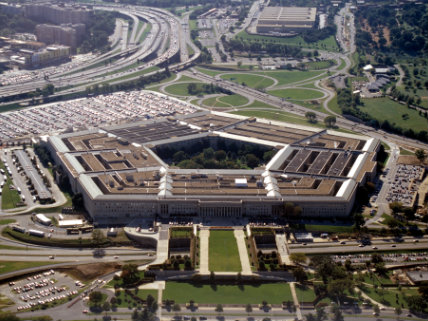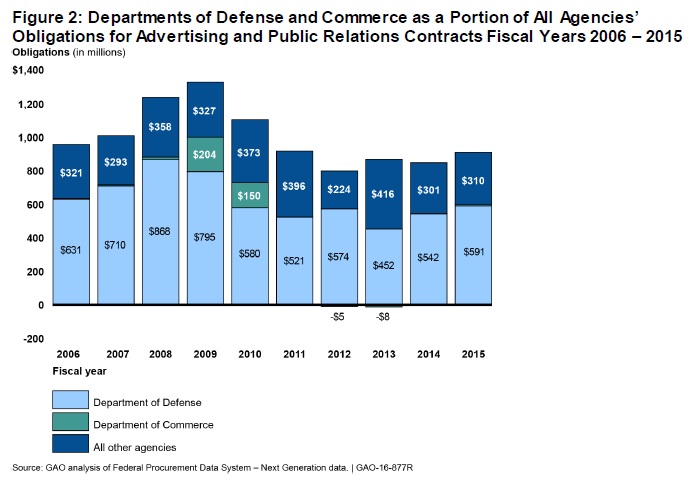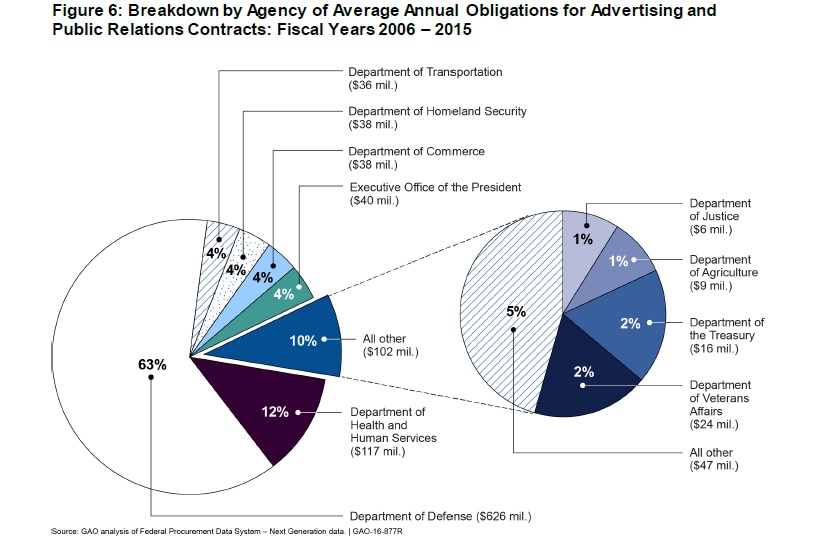The Pentagon Accounts for More Than Half of the Federal Government's $1 Billion PR Budget
More than 5,000 people work in the federal government's PR machines; more than at the Department of Education.

Selling foreign interventions and stoking the fires of patriotism isn't always easy work, but the federal government thinks someone has to do it.
That someone—or, rather, those someones—are the employees and contractors of the Department of Defense's public relations machine, easily the largest and most expensive PR operation within the United States government.
A new report from the Government Accountability Office reveals that the federal government spends more than $1 billion annually on public relations and advertising—that includes everything from press releases and safety bulletins to television ads for Obamacare, direct mailers about the importance of getting flu shots and endless streams of tweets and Facebook posts intended to connect the average American with their government.
Every department and agency in the government does it, but no one does it as much as the Department of Defense.
The Pentagon accounted for 60 percent of all public relations spending between 2006 and 2015, the GAO found, and it employs about 40 percent of the more than 5,000 public relations workers in the federal government.
For context: there are only 4,500 employees in the U.S. Department of Education.
"It is crucial to know how much is spent across the federal government on public relations activities and which federal agencies are spending the most," said U.S. Sen. Mike Enzi, R-Wyoming, who chairs the Senate Committee on the Budget and requested the study from the GAO, in a statement.
No other department comes close to what the Pentagon spends.

The second highest average over the 10 year period examined by the GAO belongs to the Department of Health and Human Services (which is responsible for some of those cringe-worthy pro-Obamacare ads). While HHS has spent an average of $116 million annually between 2006 and 2015, the Department of Defense spent more than $626 million annually.
In every year during that 10 year period, the Department of Defense spent more money on public relations than all other departments of the federal government combined. In some years—like 2008 when the Pentagon spent $868 million on public relations—it accounted for more than two-thirds of all taxpayer-funded advertising in the federal government.
To be fair, the Department of Defense's PR team has a tough job. They have to sell the American public on the value of foreign military interventions (something most Americans generally oppose) and have to spin the bombings of hospitals and the droning of innocent civilians at wedding parties as being in the best interest of America's defense—or at least as something other than war crimes.
Reason sent inquiries to the Pentagon's press office seeking an explanation for why the Department of Defense requires a public relations budget that is so much larger than other parts of the government, and asking how the department measures the success of its public relations efforts.
We have not received a response, but we will update this article to include it if we do.

The GAO report gives the overview, but it doesn't get into the details of how the Pentagon spends all that money.
For example, the report does not make clear whether the Pentagon's history of spending taxpayer money on patriotic displays at professional sporting events was included in the annual public relations budget, though it seems reasonable to assume that it would be.
The Pentagon spent more than $53 million over four years on marketing and advertising contracts with professional sports teams for pro-military displays during NFL games, NASCAR races and hundreds of other sporting events, according to a report released last year by U.S. Sens. Jeff Flake, R-Arizona, and John McCain, R-Arizona.
"Americans deserve the ability to assume that tributes for our men and women in military uniform are genuine displays of national pride, which many are, rather than taxpayer-funded DOD marketing gimmicks," the senators said.
The Pentagon also contracts with former military officials who appear frequently on cable news programs as supposed "experts" on foreign policy and military strategy. Often, those former military men and women are working for defense contractors—meaning their employers have a direct financial interest in American interventionism—but those conflicts of interest are not disclosed to TV network or to viewers, a New York Times investigation found.
Still, propping up fake experts on CNN pales in comparison to the bizarre tale of how the CIA (not technically part of the Pentagon but still part of the overall U.S. national security apparatus) invented a policy expert out of whole cloth. The fictional expert was a man named Guy Sims Fitch, whose by-line appeared in dozens, if not hundreds, of foreign newspapers during the Cold War pushing a pro-American message. Gizmodo's Matt Novak uncovered some of the details about Fitch, but the CIA denied FOIA requests about Fitch, citing a need to protect a fictional person's privacy.
The incident makes you wonder if there's any limit to what the government will do to sell it's message. The new GAO report makes clear that money is no object (and that's one more reason why Congress should consider cutting the Pentagon's budget).
A few other takeaways from the GAO report:
- While the DOD unquestionably spends the most money on public relations, it's the Consumer Financial Protection Bureau that spends the highest percentage of its budget on selling ideas to the American public. Since being launched in 2011, the CFPB has spent an average of $4.2 million annually on advertising, equal to about 0.8 percent of the agency's total budget.
- The GAO reports that the government spent an average of $1 billion annually on advertising and public relations contracts between 2006 and 2015. Spending ranged from a low of $800 million in 2012 to a high of more than $1.3 billion in 2009.
- The approximately 5,000 public relations employees in the federal government accounts for less than 1 percent of all federal workers. Their combined annual salary of $475 million in 2015 accounted for just 0.02 percent of all federal employees' salaries that year.
- The Department of Veterans Affairs saw the largest increase in public relations spending and staffers during the past decade (likely in response to media attention on a multitude of problems at VA hospitals). In 2014, the VA had 286 public relations employees, up from just 144 in 2006.

Show Comments (44)